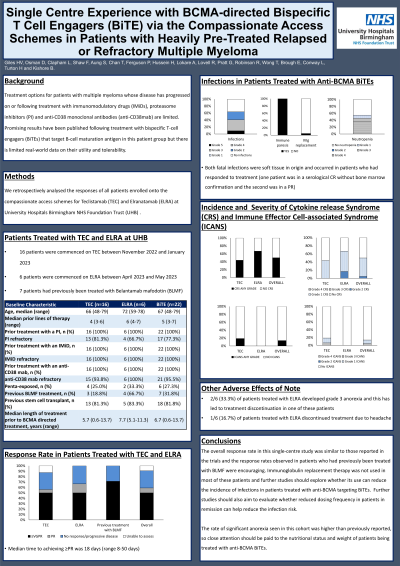Treatment of Relapsed/Refractory Myeloma
Poster Session 2
P-506: Single Centre Experience with BCMA-directed Bispecific T Cell Engagers (BiTE) via the Compassionate Access Schemes in Patients with Heavily Pre-Treated Relapsed or Refractory Multiple Myeloma (RRMM)
Thursday, September 28, 2023
12:30 PM - 1:30 PM EEST

.jpg)
Hannah V. Giles, MBChB MRCP FRCPath (she/her/hers)
Consultant
University Hospitals Birmingham NHS Foundation Trust
Birmingham, England, United Kingdom
Introduction: Myeloma is characterised by progressively shorter durations of remission due to the emergence of resistant clones. BCMA targeting BiTEs represent a novel class of drugs, which have shown promise in patients with RRMM. However, there is limited data on their use in the real-world setting.
Methods: We retrospectively analysed the responses and adverse effects of all patients enrolled onto the compassionate access schemes for teclistamab (TEC) and elranatamab (ELRA) at a large teaching hospital in England.16 patients started TEC between November 2022 and January 2023 and 6 patients commenced ELRA between April and May 2023.
Results: The median age of the patients was 67 years (range 48-79). Median number of prior lines of therapy was 5 (range 3-7). All patients were triple class exposed.17/22 (77%), 22/22 (100%) and 21/22 (96%) patients were refractory to proteasome inhibitors, IMiDs and ≥1 anti-CD38 monoclonal antibody and 18/22 (82%) had a prior stem cell transplant. 16/22 (73%) were triple class refractory.
The overall response rate (ORR) was 59%; 9/16 (56%) TEC treated patients and 4/6 (67%) ELRA treated patients achieved ≥partial response (PR). 8/22 (36%) patients achieved a complete response without bone marrow confirmation (nCR). In the 7 patients who had previously been treated with belantamab mafodotin the ORR was 71%. After a median follow-up of 6.6 months, the median progression free survival is 7.4 months and is not mature after censoring data for 12 patients.
14/22 (64%) patients have experienced at least one infectious episode (≥grade 3 in 41%). 6/22 (27%) patients have died; 4/22 (18%) have died due to progressive disease and 2/22 (9%) have died due to sepsis. Both infectious deaths were due to soft tissue infections and occurred in patients who had responded to a BiTE (one was in nCR and the second was in a PR). 12/22 (55%) patients developed neutropenia (grade 3/4 in 45%). All patients had immune paresis.
11/22 (50%) patients experienced CRS (all grade 1/2) ICANS was observed in 3/22 (14%) patients. In 2/22 (9%) patients the maximum ICANS severity was grade 1 and in 1/22 (5%) patients it was grade 3. 2/6 (33%) patients treated with ELRA developed grade 3 anorexia; this has led to treatment interruption in one patient. Anorexia was not due to chronic infection. 3/22 (14%) patients have reported headache; this has led to treatment discontinuation in one patient. 1/6 (17%) of the ELRA treated patients developed acute kidney injury due to tumour lysis syndrome.
Conclusions: In conclusion, the ORR observed in this real-world cohort is similar to those reported previously. The rate of significant anorexia in this study was higher than reported previously, so close attention should be paid to nutritional status. Infection rates were high, so further studies are needed to help us understand the optimal dosing schedule for patients in remission and infection prophylaxis regimens, particularly as two deaths in remission due to soft tissue infections were observed.
Methods: We retrospectively analysed the responses and adverse effects of all patients enrolled onto the compassionate access schemes for teclistamab (TEC) and elranatamab (ELRA) at a large teaching hospital in England.16 patients started TEC between November 2022 and January 2023 and 6 patients commenced ELRA between April and May 2023.
Results: The median age of the patients was 67 years (range 48-79). Median number of prior lines of therapy was 5 (range 3-7). All patients were triple class exposed.17/22 (77%), 22/22 (100%) and 21/22 (96%) patients were refractory to proteasome inhibitors, IMiDs and ≥1 anti-CD38 monoclonal antibody and 18/22 (82%) had a prior stem cell transplant. 16/22 (73%) were triple class refractory.
The overall response rate (ORR) was 59%; 9/16 (56%) TEC treated patients and 4/6 (67%) ELRA treated patients achieved ≥partial response (PR). 8/22 (36%) patients achieved a complete response without bone marrow confirmation (nCR). In the 7 patients who had previously been treated with belantamab mafodotin the ORR was 71%. After a median follow-up of 6.6 months, the median progression free survival is 7.4 months and is not mature after censoring data for 12 patients.
14/22 (64%) patients have experienced at least one infectious episode (≥grade 3 in 41%). 6/22 (27%) patients have died; 4/22 (18%) have died due to progressive disease and 2/22 (9%) have died due to sepsis. Both infectious deaths were due to soft tissue infections and occurred in patients who had responded to a BiTE (one was in nCR and the second was in a PR). 12/22 (55%) patients developed neutropenia (grade 3/4 in 45%). All patients had immune paresis.
11/22 (50%) patients experienced CRS (all grade 1/2) ICANS was observed in 3/22 (14%) patients. In 2/22 (9%) patients the maximum ICANS severity was grade 1 and in 1/22 (5%) patients it was grade 3. 2/6 (33%) patients treated with ELRA developed grade 3 anorexia; this has led to treatment interruption in one patient. Anorexia was not due to chronic infection. 3/22 (14%) patients have reported headache; this has led to treatment discontinuation in one patient. 1/6 (17%) of the ELRA treated patients developed acute kidney injury due to tumour lysis syndrome.
Conclusions: In conclusion, the ORR observed in this real-world cohort is similar to those reported previously. The rate of significant anorexia in this study was higher than reported previously, so close attention should be paid to nutritional status. Infection rates were high, so further studies are needed to help us understand the optimal dosing schedule for patients in remission and infection prophylaxis regimens, particularly as two deaths in remission due to soft tissue infections were observed.
